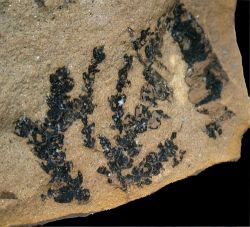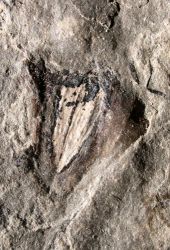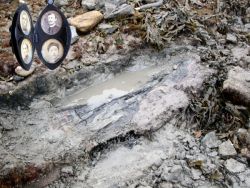Conifers
Click on the photos for more information
The conifers, including the araucaria's, formed an important part of
the Jurassic flora of Yorkshire. The most common species by far is Elatides
williamsonii, which occurs in many places. Mostly, however, only small
twigs are found. A branch like the one on the photo on the left is rather
rare. Cones are also common. The male ones are small and sometimes present
in abundance (middle photo). The female ones are larger and less common (photo
on the right).
This plant belongs to the family of the Taxodiaceae or swamp cypresses.
  A second rather
common species is Brachyphyllum mamillare (photo on the left), which
is classified in the Araucaria group, though the leaflets differ very
much from those of the living 'monkey puzzle tree'. The leaflets are very
short and thick and overlap each other. Especially near Whitby we have found
a lot of small twigs of this plant. A second rather
common species is Brachyphyllum mamillare (photo on the left), which
is classified in the Araucaria group, though the leaflets differ very
much from those of the living 'monkey puzzle tree'. The leaflets are very
short and thick and overlap each other. Especially near Whitby we have found
a lot of small twigs of this plant.
The female cones fell easily apart ànd therefore the female scales
are mostly found detached (photo on the right). The cone as well as the separate
scales are called Araucarites phillipsii.
Famous is the jet from North Yorkshire, a fine, compact, black material,
which is used to make (mourning) ornaments, lockets, dolls furniture, etc.
It is fossil wood of Aracauria trees and some other conifers and it
is collected in perfect quality at Saltwick Nab near Whitby. Since the Bronze
Age this material has been won and a complete industry has come in existence.
The museum in Whitby shows beautiful examples and gives also much information
on this industry. In several places along the beach you can find fossil trees
(click on the photo below), but in most cases they are of inferior quality.
Neither it is certain that these are potential jet trees: they can also be
other conifers.

A lot more conifers has been described, but these are all more or less
rare and we are not aware to have found them. In most cases a cuticle preparation
is needed to be sure about the species or even the genus.
Top
|